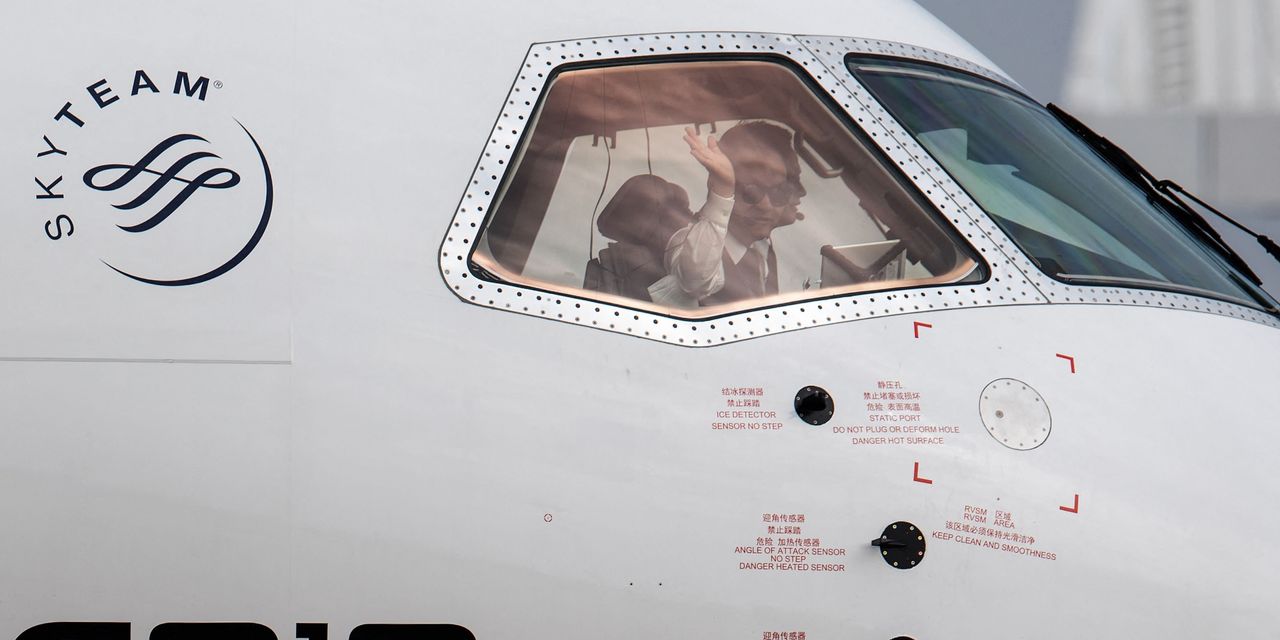Enthusiastic Chinese waved and shouted Sunday from Shanghai’s Hongqiao International Airport, as the first homegrown passenger jet took off for its maiden commercial voyage.
China hopes the C919, a narrow-body aircraft designed by the Commercial Aircraft Corporation of China, or Comac, will first compete with Boeing’s
BA,
737 Max and Airbus’s
0KVV,
AIR,
A320 — and eventually break the decades-long duopoly of those Western industry leaders.
The C919 flight, run by China Eastern Airlines
670,
CHEAF,
left Shanghai and arrived at Beijing’s Capital Airport two hours later, with state television streaming the event and observers gathered for the departure and arrival.
In a video posted on Chinese social media, a man could be heard saying, “Look at that — beautiful,” while two fire trucks sprayed the airliner with water cannons in a celebratory welcome.
Shanghai-based documentary maker Christian Petersen-Clausen was among the first foreign customers to ride on the C919, on a Tuesday flight, and said he was struck by the level of excitement at the airport, on the plane and online. “I saw a lot of pride and joy, and I think folks see it as a milestone,” he told MarketWatch.
Not only is the aircraft a source of tremendous esteem for regular Chinese; it is another sign that the country is moving up the industrial ladder toward assembling high-technology products, at a time of increasing concern from neighbors and Western countries that see China’s rise as a threat to geopolitical stability.
But getting the jet airborne wasn’t easy, with a slew of manufacturing setbacks that have made its production a 16-year slog. Moreover, many of its key parts are still produced in the West, mostly from the U.S. — a country that appears keen to squeeze China’s ability to acquire high-level technology.
Add to that the fact that financial struggles continue for China’s biggest carriers, including China Eastern, which will run the first daily route of the C919 between the cities of Chengdu and Shanghai.
The “big three” state-owned players — Air China
601111,
and China Southern Airlines
600029,
1055,
CHKIF,
alongside China Eastern — lost a combined 8.6 billion yuan ($1.2 billion) in this year’s first quarter, according to company filings.
Part of the problem appears to be attributable to China’s slow crawl back after the pandemic to allowing overseas flights, which are mostly run by bigger carriers, while smaller competitors focus on domestic regional routes, according to public flight data.
China’s smaller private carriers also lowered their prices in the first quarter, while the state-owned giants generally did not. The government’s fingerprints appeared discernible. In February, several carriers told Chinese financial-news outlet Caixin that the powerful State-owned Assets Supervision and Administration Commission actually restricted seven state-owned airlines from steeply cutting prices on major routes.
As a result, the private carriers are thriving. In the quarter that the big state-owned airlines bled cash, the three leading private carriers all reported strong profits and revenue.
That robust performance came after a crippling 2022 for the three carriers — Spring Airlines
601021,
Hainan Airlines
600221,
and Juneyao Airlines
603885,
Speaking to reporters Tuesday from a Boeing factory in South Carolina, the U.S. company’s chief executive officer, Dave Calhoun, said Comac’s new C919 “is a good airplane,” but he shrugged off the prospect of competition from China.
He said China simply doesn’t have the production capacity to meet the needs of such a vast country. Last year, Boeing forecast that China’s commercial fleet will double in number by 2041, adding 8,485 new aircraft, to match passenger demand.
“The good news for everybody is that three providers in a growing global market of this size and scale should not be the most intimidating thought in the world,” Calhoun said.
Comac’s fate may also depend on how harshly American policy seeks to punish China’s tech rise. In 2021 then-President Donald Trump temporarily added Comac to a blacklist of entities owned or controlled by the Chinese military, after previously saying he supported selling U.S.-made jet parts to China. Later lists did not include Comac.
In April, U.S. Sens. Marco Rubio and Rick Scott, both Florida Republicans, sent a letter to the U.S. Department of Commerce demanding that Comac be blacklisted. So far it has not been.
China is seeking to gradually wean itself off its huge dependency on foreign parts for its commercial aircraft. The C919 is particularly vulnerable in its engines, which are supplied by a tie-up between U.S. firm GE
GE,
and France’s Safran
SAF,
SAFRY,
Currently, these are the only engines suitable for the C919, so China has few options if it were denied this vital and difficult-to-make part.
Tanner Brown covers China for MarketWatch and Barron’s.
More from Tanner Brown:
American views of China have plummeted in recent years. Here’s what the Chinese think of the U.S.
China is not only asserting itself geopolitically but openly questioning the U.S.’s central role on the world stage
Foreign businesses in China fear they’re being targeted in a ‘campaign’ of government crackdowns. It’s probably not that simple.
Read the full article here













